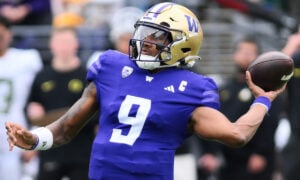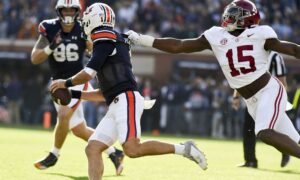Rookie Wide Receiver Athletic Comps
The combine is great because it gives an overview of a player’s athletic profile. Athletic metrics are important when evaluating wide receivers because it gives a snap shot on how a receiver can potentially win on the football field. Comparing prospects athletically to current and past NFL players can give you a visualization on how certain prospects may look. However, it doesn’t mean the player will have similar production, because there are a lot of other variables that can affect a player’s output.
Athletic metrics tells us certain things, for instance a receiver’s three-cone time lets us know how quickly a player can move latterly and get in and out of their breaks while running their routes –the lower the time the better. The 40-yard dash gives a gauge on the receiver’s straight line speed. The faster a receiver’s 40-time is the more capable the receiver is of blowing by the defensive backs when running streaks, posts and deeper routes. Height and weight are very important when analyzing these figures. It’s easier for smaller receivers to run faster because they are carrying less weight. Smaller receivers will also need to be faster because they can’t beat defenders by out-positioning and out-muscling defensive backs with their size, so they need the extra speed and quickness to create separation. Larger wide receivers can get away with being a little bit slower due them having the ability to win at the catch point with their size.
I took all the wide receivers that participated in the combine from 2008 until present date and sorted their athletic metrics to make player comps for the current rookie class of wide receivers. I sorted the data as tight as possible to get the most accurate comparisons as possible.
Geronimo Allison, WR Illinois

Allison is a tall, lanky receiver with below average speed and quickness. Tony Lippett was the only player that came close to matching Allison’s athletic profile. Lippett was asked to make a position change to cornerback when he was drafted in the fifth round during the 2015 draft by the Miami Dolphins. The major question with Allison is how can he win at the NFL level? He’s very thin and he’s not quick, fast or explosive.
Tyler Boyd, WR Pittsburgh

Boyd did not impress during the combine like a lot of dynasty enthusiast would have hoped. Allen Hurns, who caught 64 receptions for 1,031 yards and 10 touchdowns, pops up as the most comparable player to Boyd. If anything, Hurns is the light of the end of the tunnel for the Tyler Boyd fan club, proving that a player with his athleticism can be productive at the NFL level.
Aaron Burbridge, WR Michigan State

Burbridge’s combine was a disappointment as he scored below average on all of his drills. His list of comparable prospects is lackluster with Da’Ron Brown and Jeremy Williams generating limited productivity in the NFL.
Leonte Carroo, WR Rutgers

Carroo is one of the most popular wide receiver prospects in this class and he’s more than likely going to be drafted in the first round of rookie drafts. He was an explosive playmaker in college and his athletic metrics reflect that. Jermaine Kearse compares to Carroo in a lot of ways, both players are very explosive and capable of burning past the defensive backs on any given play.
Corey Coleman, WR Baylor

Coleman didn’t participate in all of the drills at the combine, so it was hard to come up with an accurate comparison for him. Since he was projected to run in the low 4.4’s to the 4.3 range, I sorted the data to give us players with similar height, weight and speed combinations. Every single one of the players listed have held some sort of dynasty value. Chris Owusu and Andre Roberts were both end of bench stashes due to their athleticism and Kenny Stills was fantasy relevant as a deep threat for the Saints. Percy Havin is the most notable player on this list as he was a viable WR1 during the early years of his career. Coleman’s more dynamic than all the players listed and he’s highly likely going to be a first round draft pick.
Pharoh Cooper, WR South Carolina

Cooper didn’t participate in most of the workouts, which makes it hard for us to come up with players that compare to him athletically. The only player that popped up with a similar height and weight was Dwayne Harris, who is a better football player than fantasy asset due to his role on special teams as a punt returner.
Josh Doctson, WR TCU

Doctson is a unicorn when it comes to his athletic profile because there are not many wide receivers that moves as well as he does at his height and weight. His combine metrics optimizes his player profile and makes him one of the top dynasty prospects in this draft.
Will Fuller, WR Notre Dame

Fuller did what he had to do and that was run in the 4.3’s for his 40-yard dash. All the players listed have held some dynasty value during their career as an end of bench stash or as an every week starter. T.Y. Hilton’s production in the NFL with three seasons in a row eclipsing the 1,000 yard mark in receiving yards makes him a very intriguing player for Fuller to be compared too.
Keyarris Garrett, WR Tulsa

The one thing this wide receiver class lacks is the size/speed freak athlete that is projected to be drafted in the mid to late rounds. Garrett is the closest prospect to fit into that mold as he’s 220 pounds with a 4.53 40-yard dash. He’s going to be a mid to late round favorite in rookie drafts.
Rashard Higgins, WR Colorado State

Higgins, a fan favorite for a lot of dynasty aficionados, disappointed at the combine with suboptimal workout numbers. His vertical and 40 time were below average and he did not run the three cone which is an important workout for wide receiver evaluations.
Braxton Miller, WR Ohio State

Miller remains a project as he is still learning the wide receiver position, but you can’t deny his athleticism. His three cone time of 6.65 suggests that he is capable of smoothly getting in and out of his breaks while running his routes with elite quickness. Miller used his athleticism to showcase his abilities during the Senior Bowl practices as he was a nightmare for the defensive backs to cover.
Malcolm Mitchell, WR Georgia

Odell Beckham is an elite route runner and not many players actually compare to him, but he pops up as an athletic comparable to Mitchell. Mitchell’s combine numbers demonstrates that he can win with his ability to quickly get in and out of his breaks while running routes.
Marquez North, WR Tennessee

He’s an intriguing prospect due to his size and athleticism, but he wasn’t productive in college and that’s the major road block keeping him from becoming a sought after prospect. He played three seasons in college and only accounted for 874 yards and five touchdowns during his entire career. He’s going to be a trendy late-round flier in rookie drafts.
Jordan Payton, WR UCLA

He compares to Justin Blackmon and Devante Parker athletically, and both players were first-round picks. Blackmon was tremendously productive before his off the field habits got in the way of his ability to play football. DeVante Parker is currently a promising dynasty asset that is on the rise. Payton wasn’t hyper-productive but he owned 29.50 percent of the market share of UCLA’s passing offense. He’s going to be a wise investment during the middle rounds of rookie drafts.
Charone Peake, WR Clemson

Peake tore his ACL during 2013 which stifled his college career, derailing his productivity until his senior season. He has the size, speed and quickness to be competitive at the NFL level, but he has to figure out how translate his athletic gifts into on field production. He deserves a second glance of film watching before making any final evaluation due to his terrific combine performance.
Demarcus Robinson, WR Florida

He has a very impressive three cone but his long speed isn’t optimal. He wasn’t a dominate player in college but he did provide a 37.53 market share of the passing offense during his junior season in 2014. However, those stats are a little bit inflated due to Florida’s passing game being in shambles that season and producing just 179.9 yards per game passing. His profile suggests that he could be a late-round flier in rookie drafts.
Tajae Sharpe, WR Massachusetts

Sharpe was highly productive in college as he caught 111 receptions for 1,319 yards and five touchdowns during his senior season. He’s a tall, thin wide receiver that’s doesn’t have the speed to burn defensive backs. Since he was very productive in college we need to go back to the tape and be extra diligent while watching him to get the appropriate evaluation of his skill set.
Sterling Shepard, WR Oklahoma

Shepard compares athletically to Randall Cobb and Kendall Wright and like both of those receivers he’s a great route runner. Shepard is the best route runner in this draft class and he does a really good job at maximizing his athleticism to create separation from defenders. He will be valued as mid to early first round pick in rookie drafts.
Michael Thomas, WR Ohio State 
Davante Adams, Brandon LaFell and Rueben Randle are all notable dynasty prospects who were valued as the next potential breakout wide receiver. He has the prototypical size for a starting wide receiver and if he can use his quickness to perfect his craft of route running he could be a dangerous at the next level.
Laquon Treadwell, WR Ole Miss

Treadwell didn’t run at the combine, but many analysts guess that he would run in the 4.6 range. Above are comparable prospects that ran close to a 4.6 40 yard dash. Allen Robinson’s name pops off the list because he is currently one of the top assets in dynasty. From a production standpoint, the rest of the list is easily forgettable. For Treadwell’s athletic metrics we don’t have as much data as we would like, so that means will need to put in extra time studying film to get the most accurate assessment on his skill set.
D’haquille Williams, WR Auburn

Williams is risking going undrafted after his dreadful combine performance. His combine scores demonstrate that he doesn’t have the speed, burst and short area quickness to compete in the NFL. It’s hard to make a case to draft him when you combine is off the field issues with his horrid athletic metrics.
De’Runnya Wilson, WR Mississippi State

Deservingly, many jokes have been made about Wilson’s 40 time due to it being the slowest ever for a wide receiver. He was so slow that there are no receivers that compare to him. He was one of the biggest losers from the combine and his dynasty stock plummeted.
Analyzing combine metrics is just part of the process when prepping for rookie drafts. We also need to examine a player’s film and college production during our player evaluations. Keep in mind, a player can check all the boxes and still become a bust, but by doing the extra work you will increase your hit rate in rookie drafts.
- Dynasty Fantasy Football Rookie Profile: Luke McCaffrey, WR Rice - April 19, 2024
- 2024 Dynasty Fantasy Football Rookie Profile: Will Shipley, RB Clemson - April 6, 2024
- 2024 Dynasty Fantasy Football Rookie Profile: Braelon Allen, RB Wisconsin - March 29, 2024


































































